OpenAI completely changed how we work, think, and get things done—just by handing smart AI tools to regular people.
ChatGPT, GPT-4… suddenly, we all had a personal assistant that could help write emails, build apps, and even explain things better than most of us can.
And now? Over 120 million people use it every single day. That’s huge!
But before all the hype, the funding, and the growth, they had to pitch. Like any startup. They had to explain their idea, make it sound clear, and get people to believe in it.
Today, I’m breaking down their sample pitch deck to see how they told that story, and what you (or any founder) can learn from how they did it.
Let’s start by checking out OpenAI’s pitch deck.
About OpenAI (then vs. now)
Back in 2015, OpenAI wasn’t ChatGPT or DALL·E or an API business. It wasn’t selling anything at all.
It started as a nonprofit research lab with one big idea: What if artificial general intelligence could be developed safely and benefit everyone, not just whoever got there first?
There was no product or business model. Just a mission statement, a blog post, and a $1 billion funding promise (with only about $130 million in those early years).
The founding team included Sam Altman, Ilya Sutskever, Elon Musk, and Greg Brockman. They wanted to guide AI responsibly from the start, which gained a lot of attention.
By 2019, research costs pushed them to adopt a capped-profit model from a lab. Microsoft invested $1 billion that year, starting its major partnership. This sets the stage for OpenAI’s business future.
When this pitch deck was made, OpenAI was gearing up to introduce GPT-4. It wasn’t their first model, but it was a turning point. They had momentum, but were still figuring out pricing, scale, and how to pitch the vision clearly.
Now, they’re everywhere. ChatGPT became the fastest-growing app in history. GPT-4 changed how people work. Its valuation jumped from $1 billion in 2019 to $300 billion as of now.
(Still, the core mission stayed in focus.)
Slides in the deck
Detailed OpenAI pitch deck analysis (slide-by-slide)
Now let’s get into the actual slides. What I care about and what I think matters most is how each slide pulls its weight.
Here’s a slide-by-slide breakdown of OpenAI’s sample pitch deck, introducing ChatGPT-4. What’s on it, why it works (or doesn’t), and the one thing you should take away from it if you’re working on your own deck.
1. Title
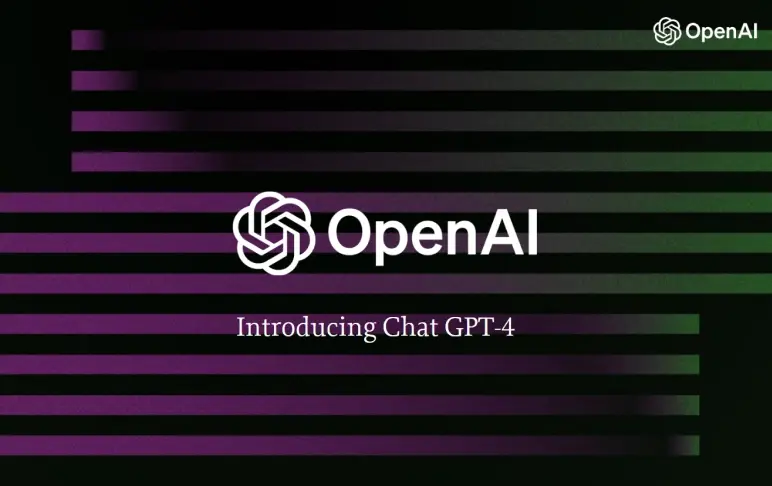
This slide is clean and confident, simply announcing “Introducing Chat GPT-4” with the OpenAI brand front and center.
The minimal approach feels intentional, suggesting authority without trying too hard to explain. It immediately sets a serious, premium tone.
Takeaway: Don’t overthink your title. A strong product name and brand carry weight on their own.
2. Introduction
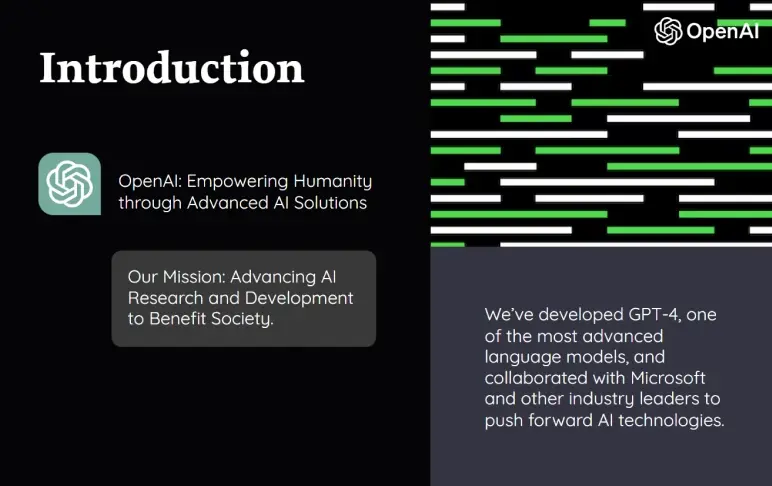
This introduction slide sets a clear, mission-driven tone right away. It emphasizes OpenAI’s goal of “Empowering Humanity through Advanced AI Solutions,” and shows their commitment to advancing research to benefit society.
Mentioning GPT-4 and Microsoft shows real impact and strong backing. GPT-4 proves its tech leadership, while Microsoft signals investor confidence and support.
Takeaway: A mission-led introduction paired with proof of major collaborations helps gain trust and align investors with a bigger purpose.
3. Problem
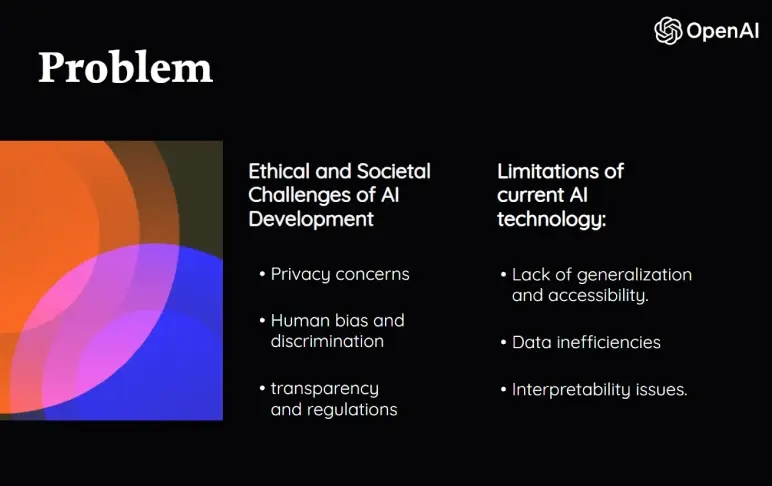
I think this is one of the strongest slides because they don’t shy away from real issues: privacy concerns, bias, transparency, and regulation.
They also highlight tech limits like poor generalization, data inefficiencies, and interpretability issues. This makes the problem tangible and serious, showing there’s real work (and value) in solving it.
Takeaway: Listing out real challenges builds trust and proves there’s a meaningful problem to solve.
Ditch your old-school pitch deck creation methods
Make compelling pitch decks in minutes with AI
Plans starting from $14/month
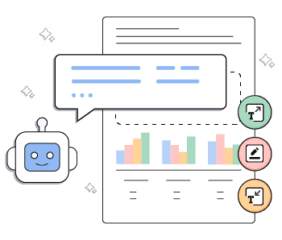
4. Solution
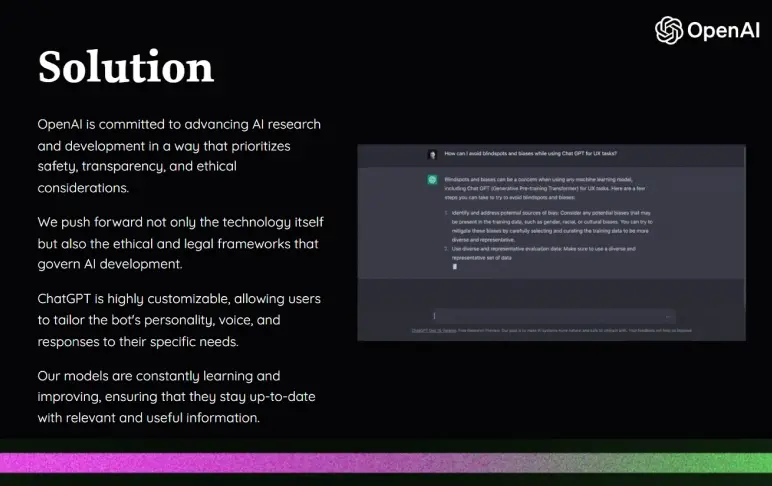
This slide explains how OpenAI tackles the problem with a focus on safety, transparency, and ethics.
It’s clear that they’re not only building powerful technology but also making it customizable and responsible. This signals that they understand the risks and are serious about doing AI the right way.
Takeaway: Showing a thoughtful, ethical solution helps investors trust both the tech and the team behind it.
5. Product
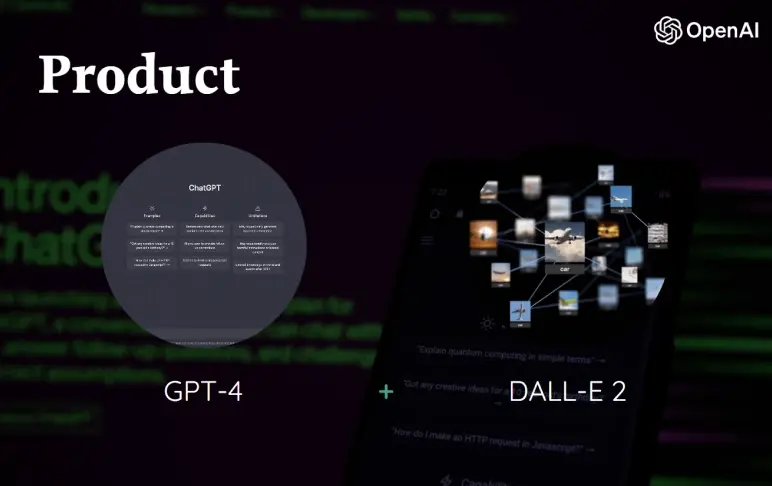
This slide highlights two flagship products: GPT-4 for text and DALL-E 2 for images.
The “+” signals they’re complementary parts of OpenAI’s suite, showing range across language and visual AI. It positions them as a versatile platform, not just a single-product company.
Takeaway: When your product is strong, let it speak for itself—show the core.
6. Market Size
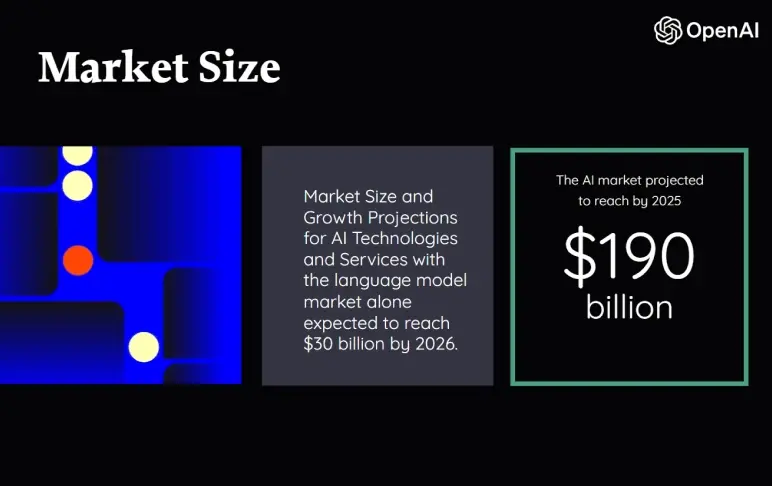
This slide lays out big numbers: a $190 billion AI market by 2025 and $30 billion just for language models by 2026.
It shows there’s serious growth potential and plenty of room for OpenAI to capture value. Investors can see a huge, expanding market that justifies ambitious goals.
Takeaway: Use real, believable market numbers to show investors there’s enough room for your business to grow.
7. Business Model
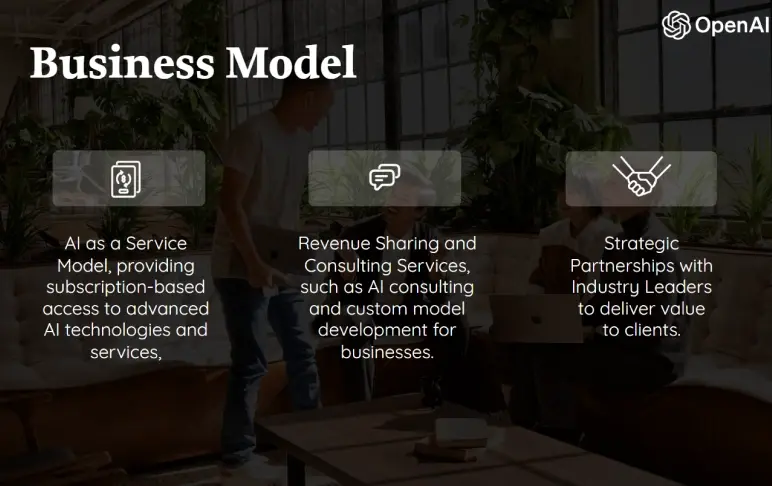
This slide explains how OpenAI makes money through subscriptions, consulting, and strategic partnerships. It shows they’re not relying on a single revenue stream but on various services and collaborations.
That kind of layered model helps reduce risk and appeal to different customer segments.
Takeaway: Offer multiple, clear revenue streams to show investors you have a flexible, lower-risk plan to grow.
8. Underlying Magic
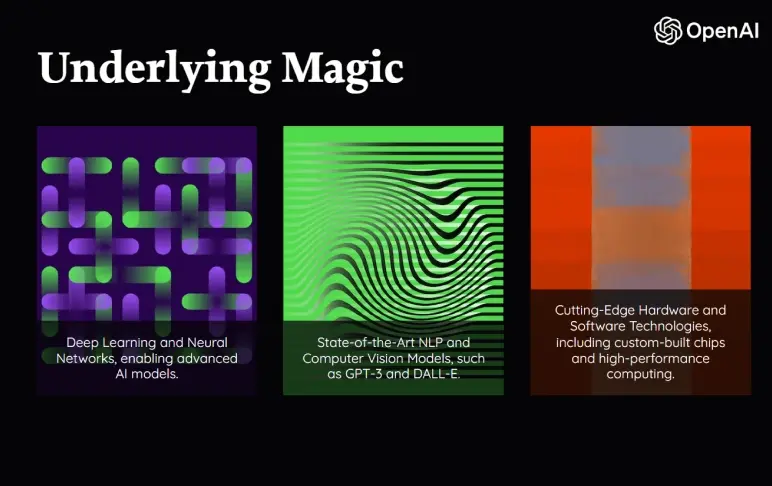
This slide shows the three core pillars behind OpenAI’s tech: deep learning models, powerful NLP/vision tools, and strong hardware/software systems.
I like the fact that it’s short and clean. Each panel gets its own space, and the visuals feel modern but not distracting. You don’t need to be technical to understand that “this stuff runs on serious infrastructure.
Takeaway: Highlighting core tech pillars proves there’s real innovation driving the product, not just marketing gloss.
9. Competition
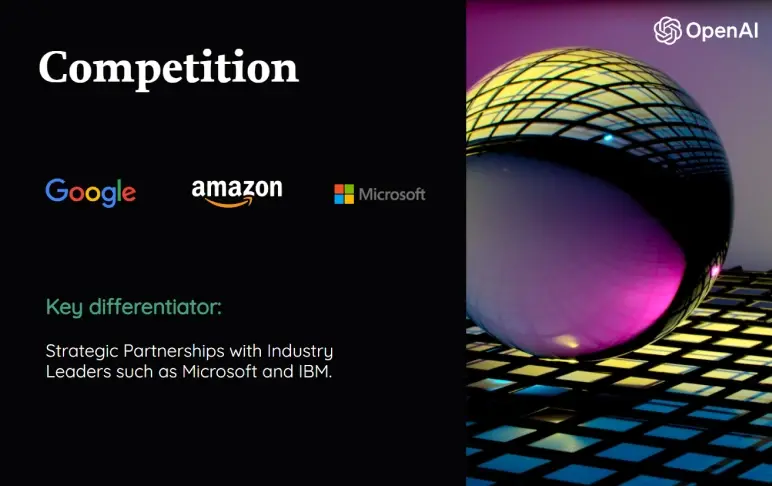
They’re not hesitant about naming the tech giants like Google, Amazon, and Microsoft as competitors. But instead of going head-to-head, they highlight partnerships as their edge.
That line about Microsoft and IBM isn’t just fluff—it positions OpenAI as aligned with the powerful players, without trying to outpace them.
Takeaway: Smart positioning turns potential threats into collaborators, and that’s a strategic win (in investors’ eyes).
10. Why us
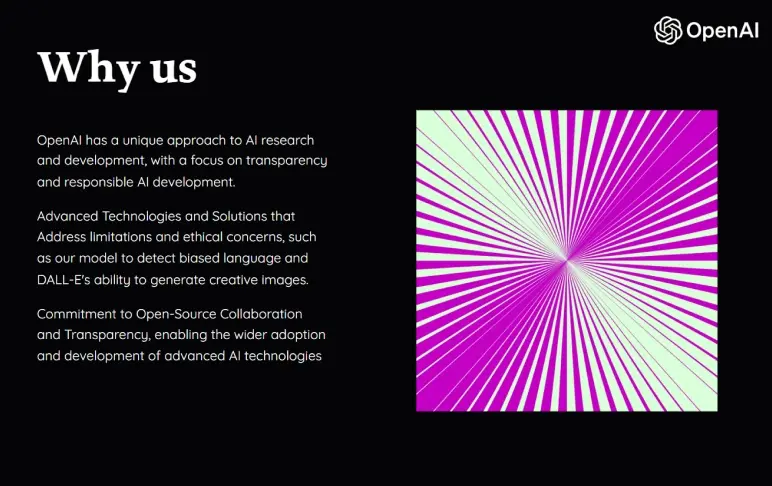
This slide explains why OpenAI believes it stands out, focusing on transparency, responsible AI development, and solutions that address ethical challenges.
It also emphasizes open-source collaboration to show they’re committed to broader industry impact. This helps build trust with investors who want to see long-term thinking with a differentiated position in a competitive space.
Takeaway: In a space full of hype, values like openness and ethics can be real differentiators, especially when backed by strong tech.
Ditch your old-school pitch deck creation methods
Make compelling pitch decks in minutes with AI
Plans starting from $14/month

11. Marketing Plan
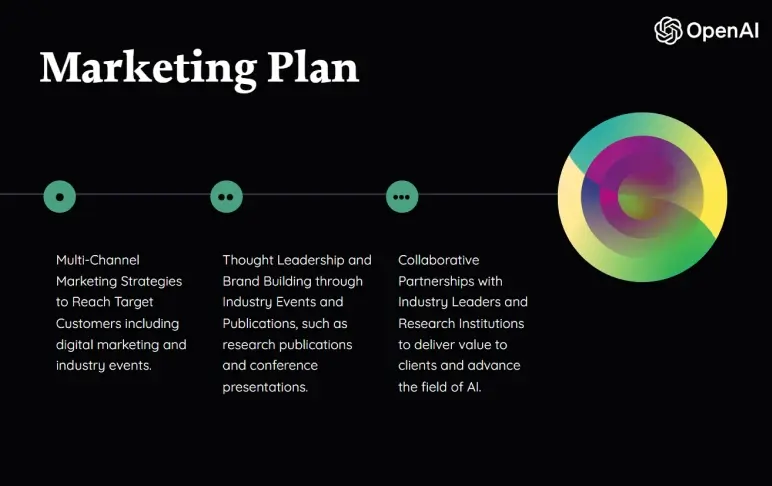
This slide lays out a multi-channel approach: digital marketing, industry events, thought leadership, and strategic partnerships. It shows they’re not relying on one channel but building trust and credibility through multiple approaches.
Also, it indicates that they’re serious about educating the market and collaborating with industry leaders.
Takeaway: A thoughtful marketing strategy signals they know how to grow adoption and strengthen their brand in a competitive space.
12. Team
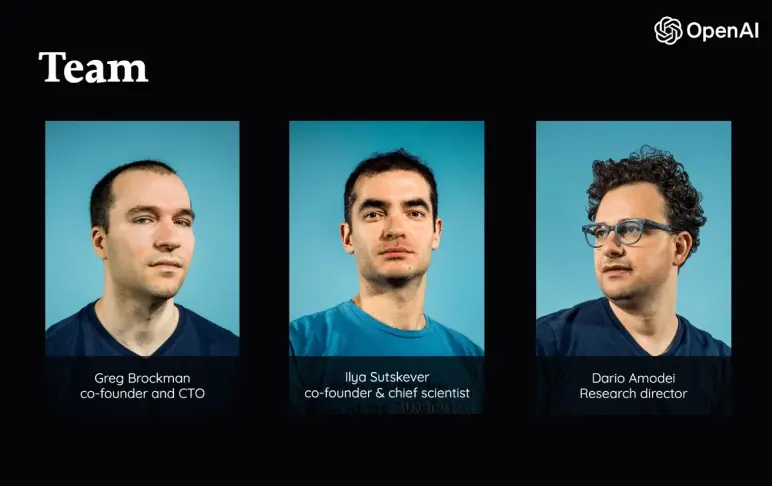
This slide puts a spotlight on OpenAI’s leadership with co-founders and the top researcher director. All three bring deep expertise in AI research and development, with proven backgrounds in both academia and real-world applications.
It shows credibility, signaling that the team has the talent to deliver on big AI promises.
Takeaway: Highlighting an experienced, committed team helps prove they can actually execute on ambitious goals.
13. Milestones and traction
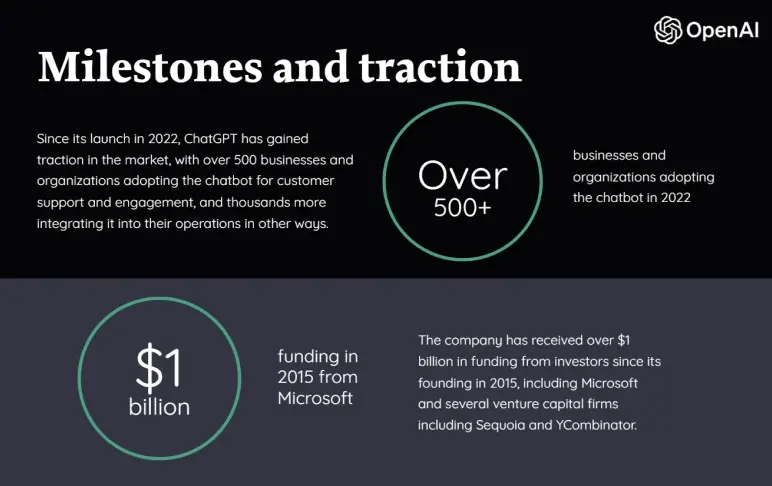
This slide highlights strong early adoption with over 500 businesses using ChatGPT in 2022.
It also underlines serious backing, mentioning over $1 billion in funding with major investors like Microsoft. These details help prove that demand is real and the company has the resources to keep growing.
Takeaway: Showing both market traction and heavyweight investment builds investor confidence in momentum and stability.
What did I like the most about this deck?
Looking at OpenAI’s pitch deck, what really stood out to me is how focused and credible it is.
Here are a few more points that I liked:
- They owned the problem. Privacy, bias, transparency—real issues, clearly stated. No sugarcoating.
- The solution felt grounded: safety-first, ethics-focused, and built for real-world use.
- The product slide was focused and confident, just GPT-4 and DALL·E. No clutter, just core value.
- The market size was big but believable. No TAM inflation, just real growth potential.
- Competitors were named, not hesitant; instead, they used partnerships to show strength, not weakness.
Every slide had a purpose. You could read it solo and still get the full story. It’s a good example of how to pitch something complex without overcomplicating it.
Perfect your deck and pitch using Upmetrics
OpenAI’s pitch deck is a great reminder that you don’t need a loud or complicated deck to raise serious capital. What matters is clarity, confidence, and showing you understand the space you’re in, tech, traction, team, and a clear mission.
Working on your own pitch deck? Upmetrics can help. It’s an AI-powered planning software that helps entrepreneurs and business owners with their business plans and presentations.
Use our AI pitch deck creator to build a clear, professional pitch deck in minutes.
Or want something customized? Use our pitch deck design service to work with expert consultants who’ll craft an investor-ready presentation for you!
Ditch your old-school pitch deck creation methods
Make compelling pitch decks in minutes with AI
Plans starting from $14/month

